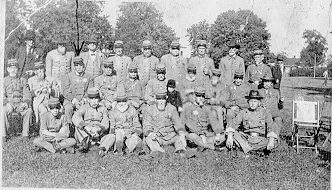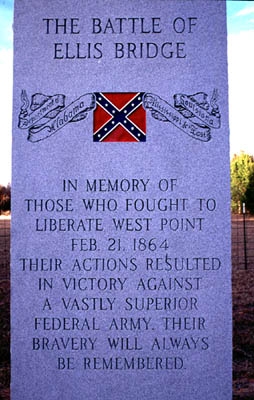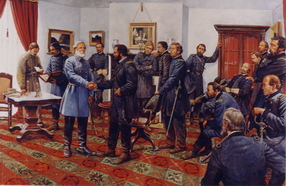3. LaFayette, GA June 24th,
1864
"La Fayett Ga" W. T. McKnight (first battle W. T. McKnight was in.)
(email from William
G. Rambo, Park Director of Confederate Memorial Park Alabama,
Sept 8, 1998 ) "Moving into north Georgia, the regiment was
in the desperate encounter at LaFayette (24 June 1864), with a
loss of 30 k and w,and about 75 prisoners. " from Alabama
Confederate States Calvary Units 8th Alabama Cavalry
[Ball's-Hatch's] assigned to C. G. Armistead's brigade.
An excellent web page on the
Battle of LaFayette
has come from
Mike Keown who lives in LaFayette, Gerogia.
Dear Gentlemen,
I live in Lafayette Ga. And the reason for my question is that I am
researching the battle of LaFayette. We have 16 unknown confederates buried
here. I am bound and determined to name those men. So far I have learned that
the battle was primarily fought by Armisteads Brigade, as Col Neely and Gen
Pillow were late. I found Spence's report and thought bradshaw might be one
of the unknowns.
Armistead's brigade contained (as far as I know) the 12th Miss, 8th Ala
(ball-hatch's), and Lewis' (harrel's) cavalry battalion. Harrel, in his
report listed 1 killed, 5 wounded. The 8th Alabama lists 30 killed.
So it is my guess that the 16 came from either the 8th Al or the 12th Miss.
With kindest regards,
Mike Keown
4. Ponotoc & Tupelo. July 14-15, 1864
"With Forrest at West Point,
Ponotoc & Tupelo " W.
T. McKnight
Tupelo
(The
American Civil War )Tupelo Harrisburg Mississippi American
Civil War July 14-15, 1864 Maj. Gen. A.J. Smith, commanding a
combined force of more than 14,000 men, left LaGrange, Tennessee,
on July 5, 1864, and advanced south. Smith's mission was to
insure that Maj. Gen. Nathan B. Forrest and his cavalry did not
raid Maj. Gen. William T. Sherman's railroad lifeline in Middle
Tennessee and, thereby, prevent supplies from reaching him in his
campaign against Atlanta. Laying waste to the countryside as he
advanced, Smith reached Pontotoc, Mississippi, on July 11.
Forrest was in nearby Okolona with about 6,000 men, but his
commander, Lt. Gen. Stephen D. Lee, told him he could not attack
until he was reinforced. Two days later, Smith, fearing an
ambush, moved east toward Tupelo. On the previous day, Lee
arrived near Pontotoc with 2,000 additional men and, under his
command, the entire Confederate force engaged Smith. Within two
miles of the Federals, on the night of the 13th, Lee ordered an
attack for the next morning. Lee attacked at 7:30 am the next
morning in a number of uncoordinated assaults which the Yankees
beat back, causing heavy casualties. Lee halted the fighting
after a few hours. Short on rations, Smith did not pursue but
started back to Memphis on the 15th. Criticized for not
destroying Forrest's command, Smith had caused much damage and
had fulfilled his mission of insuring Sherman's supply lines.
5. Mobile, AL August 2-23, 1864
"Mobile & ...." W. T. McKnight
Naval
battle was the beginning of the end for the Confedercy
The
American Civil War Mobile Bay Alabama Passing of Forts Morgan
and Gaines American Civil War August 2-23, 1864 A combined Union
force initiated operations to close Mobile Bay to blockade
running. Some Union forces landed on Dauphin Island and laid
siege to Fort Gaines. On August 5, Farragut's Union fleet of
eighteen ships entered Mobile Bay and received a devastating fire
from Forts Gaines and Morgan and other points. After passing the
forts, Farragut forced the Confederate naval forces, under Adm.
Franklin Buchanan, to surrender, which effectively closed Mobile
Bay. By August 23, Fort Morgan, the last big holdout, fell,
shutting down the port. The city, however, remained uncaptured.
6. Rome, GA October 12, 1864
"Were in battle near Rome Ga (horse
shot from under me)." W.
T. McKnight
(email from Jim Moore,
Sept 16, 1998, see group of letters) Colonel Armistead being
ordered to Rome, GA by Gen. Hood. Armistead acted as General
there. William
S. Moore's pension files mention that he was in Rome, GA with
Armistead. (from copy of hand written letter, Aug 5, 1910,
Russellville, AL, by L. J. Burcham) Armistead was ordered to Rome
Georgia with sever other regs. of cavalry and he acted as a
general there and the rest of the war and Phillip Spence acted as
colonel) "Shortly after, the 8th (Alabama Cavalry) fought at
Rome, losing about 20 men k and w." Alabama
Confederate States Calvary Units 8th Alabama Cavalry
[Ball's-Hatch's] assigned to C. G. Armistead's brigade.
Email from Dr. Don Ervin Woolf about his gg-grandfather James Ervin Woolf who was kiled at the Battle of Rome, Georgia. His email includes a letter that his gg-grandfather wrote home to his wife just before he was killed. 11-Dec-2000
An excellent description of the battle at Rome Races
comes from David Slay, 21-Nov-99.
The "Rome Races" is what the 8th Texas Cavalry
called the battle, with tongue in cheek.
David Slay has expaned his description of the
"Rome Races"
and is available online. 12-Dec-2001.
7. Turkey Town, AL October (late), 1864
"Was with Wheeler at Turkey Town
& many other battles. " W. T. McKnight
Major General Joseph Wheeler
(email from David Slay, 21-Nov-99 )
I think this may be Turkey Town, Alabama. After the Rome Races and the
brigade became organized again it proceeded to rejoin Hood's army. After
Hood had finished his task in Northwest Georgia he moved into Alabama. The
two armies skirmished at Gaylesville, Little River, and other points on the
northern bank of the Coosa River. Once again Armistead's men were called
into action as a screen. Between Gaylesville and Gadsden, Alabama, on the
Coosa River, is a small hamlet called Turkey Town.
8. Battle At Pine Barren Creek, Florida, December 16-17, 1864
"Was in battle at Millnery Farm, Bluff
Springs (near Pensacola Fla) shot by negro yank & I killed
him. (Yanks fought us with negros). " W. T. McKnight

On December 16, 1864 Federal troops of the 82nd and 97th U.S. Colored Infantry attacked Pollard, Alabama with orders to destroy the railroad. The Federals easily defeated the small Confederate force of General James H. Clanton. After destroying part of the tracks and burning several government buildings they headed back to Barrancas near Pensacola. The Confederates gathered Baker's Brigade and Armistead's Brigade from Blakely to engage the Federals. Led by General Liddell, the Confederates moved 150 miles in 54 hours and caught up to the Federals about six miles south of Pollard. The rebels burned bridges across the creeks that empty into the Escambia River and engaged the enemy at each burned bridge. The rebels routed the 82nd at Mitchell's Creek and on the night of December 17th the rebels attacked the negro troops at Pine Barren Creek. The Federals lost eighty killed or wounded and ten wagons were now in Confederate hands. The remainder escaped back to Barrancas only because the Confederates gave up pursuit because their horses were giving out. This battle is also known as Mitchell's Creek and Bluff Springs.
9. Pollard, AL January, 1865
"Yanks came out from Pensacola
& cut RR at Pollard . " W. T. McKnight
"It (8th Alabama Cavlary) was ordered to west Florida
soon after, and it was in front of Union Gen'l Frederick Steele
as he moved on Pollard." Alabama
Confederate States Calvary Units 8th Alabama Cavalry
[Ball's-Hatch's] assigned to C. G. Armistead's brigade.
From web page "Pollard Yesterday".
Steamboats once plowed the Conecuh River carrying cargo to and
from Pollard. The town was, in its heyday, an important rail center
and was a vital Confederate military post during the War Between States.
The post was headquarters for CSA troops detailed to keep and eye on Pensacola, Fla.
In January, 1865, there was a battle in Pollard with Confederate troops
under Gen. J.H. Clanton clashing with a body of federal raiders. The town was later burned.
10.Spanish Fort, Alabama March 27-April 8, 1865
"lost mule in battle near Spanish
Fort, Ala. Came near being captured (by yanks). " W. T. McKnight
The
American Civil War March 27-April 8, 1865 Maj. Gen. E.R.S.
Canby's XIII and XVI corps moved along the eastern shore of
Mobile Bay forcing the Confederates back into their defenses.
Union forces then concentrated on Spanish Fort and Fort Blakely.
On March 27, 1865, Canby's forces rendezvoused at Danley's Ferry
and immediately undertook a siege of Spanish Fort. The Union had
enveloped the fort by April 1, and on April 8 captured it. Most
of the Confederate forces, under the command of Brig. Gen.
Randall L. Gibson, escaped and fled to Mobile, but Spanish Fort
was no longer a threat.
"Some Recollections Of An Old Soldier"
by by Asa M. Piper, Company C, 62nd Regiment of Alabama Volunteers, C. S. A.
11. Selma, AL April 1, 1865
Selma, Alabama April 1, 1865 The Selma
Campaign Confederate Order of Battle, at Selma Serving under
N.B. Forrest, among others was: Buford's Division - Brig. Gen.
Abraham Buford Armistead's Brigade - Col. Charles G. Armistead
(part of Buford's Division) Confederate
Order of Battle (Note: Forrest was attempting to form
Buford's Divison, but this unit would never be a cohesive force.)
James P.
Miller captured the standard of the 12th Mississippi Cavalry
and received the Medal of Honor. The Iowa Civil War Site Iowa
During the Civil War Iowa Medal 1- Miller, James P. 2- private,
Company D, 4th Iowa Cavalry 3- Selma, AL, 4-2-65 4- Henry County,
IA 5- Franklin, OH 6- 6-17-65 7- Capture of standard of 12th
Mississippi Cavalry (C.S.A.)
CIVIL WAR
MEDAL OF HONOR RECIPIENTS MILLER, JAMES P. Rank and
organization: Private, Company D, 4th lowa Cavalry. Place and
date: At Selma, Ala., 2 April 1865. Entered service at. Henry
County, lowa. Birth: Franklin, Ohio. Date of issue: 17 June 1865.
Citation: Capture of standard of 12th Mississippi Cavalry
(C.S.A.).
W.T. McKnight was paroled May 4th, 1865 at Gainsville, Alabama



